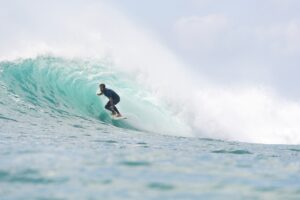Surfer’s Ear

A common disease among surfers is the dreaded surfer’s ear (exostosis), a bone proliferation in the ear and clogged ears.
The most important step in caring for your ears as a surfer is to get the water out of your ears and keep your ear canals dry . This may seem obvious, but as any surfer will know, it’s not that simple.
7 tips to get water out of the ears
As surfers, we have some tips that can help you get the water out of your ears or prevent the problem from arising in the first place. Let’s review our recommendations:
Let Gravity Do The Work
The first and easiest step is to let gravity do the work for you . This method will solve the problem in most cases and of course you will feel the need to do it.
If water gets stuck in the ear, you will need to tilt your head to the affected side to help drain the water from the ear. If you take a few minutes to lie down and place your affected ear on a pillow or towel, gravity will often do the work for you.
Pull On Your Earlobe
If you don’t feel any relaxation when you tilt your head toward the affected ear, try gently pulling on your earlobe at the same time to create extra space in your ear canal.
Move Your Jaw
Another step you can try to release stuck water in your ear is to add a bit of jaw movement. Gently move your jaw by yawning or chewing while performing the previous two steps. This process creates pressure in the Eustachian tubes and releases water that has collected in the ears.
The Valsalva Maneuver
Most of us are familiar with this technique from scuba diving or air travel. In both scenarios, our ears tend to build up pressure that needs to be relieved in order not to cause pain or damage to our ears.
To use this technique, you must close your mouth, cover your nose, and blow gently with moderate force . This technique will help equalize the pressure in the ears and drain any trapped water.
Vacuum Technology
The last thing you can try without tools is the vacuum technique. Simply place your palm over your covered ear to create an airtight seal , then hold for a few seconds, preferably with your head tilted to the side. You can increase the effect by gently squeezing your hand back and forth toward the ear in a quick motion, creating a suction effect that helps relieve any pressure on the ear. The vacuum effect should eventually help remove any trapped water from your ear.
Hair Dryer
A practical way to remove water from the ear is to use a hair dryer . At medium speed and medium temperature, a slow, steady blow with a hair dryer will eventually dry out your ears and remove the water from your ears. But you have to be very careful when using heat.
There are USB-based mini hair dryers that plug into your car’s cigarette lighter socket. You can use it immediately when you get out of the water.
Alcohol-Based Ear Drops
Suppose the water is stuck and has mixed with wax or is stuck behind the wax. In this case, the alcohol-based ear drops will soften the wax , mix with the water, and eventually the alcohol will dry out, simultaneously drying up the water in the ears.
How to prevent surfer’s ear
It’s good to know how to get water out of your ears to prevent surfer’s ear, but why not prevent water from getting stuck in your ears in the first place?
Silicone Stopper
Many people use moldable silicone ear tips when surfing. With manual movement and heating, the silicone molds to the ear and stays in place while you ride.
Suppose it falls off and has to be reformed and reinserted. In this case, the silicone has a secondary function, removing water from the internal crevices of the ear.
surfing ear plugs
The best way to avoid getting water in your ears is to put on the floating surf earplugs . This prevents water from getting in there at all.
Wearing a wetsuit hood helps with this and keeps earplugs in place. Silicone ear tips are also effective.
the best advice
The best advice is not to put anything in the ears . Putting a plug in your ears can potentially push the earwax deeper and trap water behind it.
Many medical professionals advise against putting anything in your ears, but sometimes a small, pointed piece of tissue paper can be used to collect small droplets of water. It’s not tight enough to push the earwax out more, but it can help get the water out of your ears.
It is good advice for surfers to professionally wash their ears regularly with lukewarm water .





